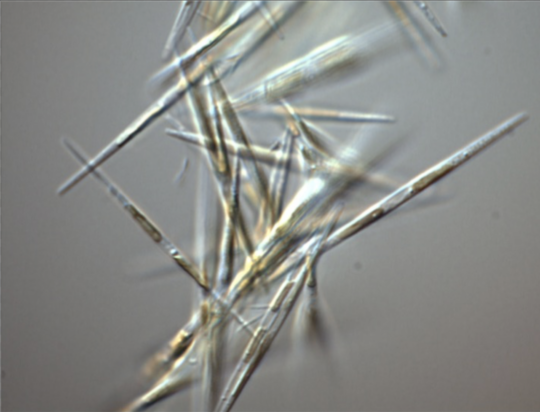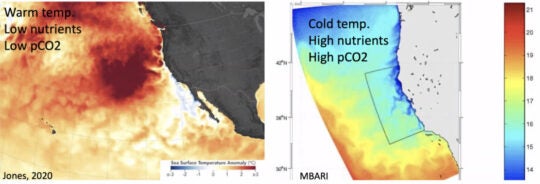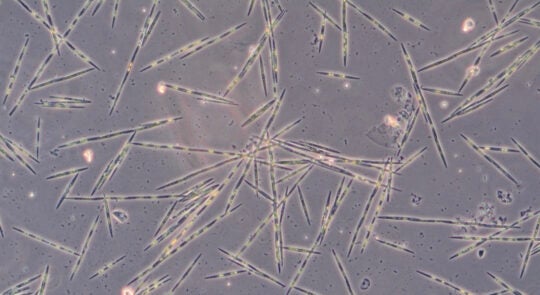Future changing environmental conditions may lead to more harmful algal blooms
Harmful algal blooms (HABs) of several toxic diatom species within the genus Pseudo-nitzschia annually cause significant damage to ecosystems and economies along the California coast. Pseudo-nitzschia can produce the neurotoxin domoic acid, which can cause fish kills, marine mammal sickness, and cause severe health issues in humans who consume contaminated seafood. Recent evidence suggests that increased nutrient availability due to either anthropogenic pollution or climate-driven shifts in upwelling patterns can combine with other individual factors (e.g., temperature and carbonate chemistry) to significantly increase the toxicity of these blooms. Little is known about how projected future changes of these combined factors will affect HAB frequency in California. University of Southern California (USC) Sea Grant funded a project to conduct multi-stressor studies with Pseudo-nitzschia cultures isolated from California waters to predict how future environmental conditions may influence damaging, toxic blooms.
Key Results:
- Experiments simulating coastal upwelling conditions (i.e., cooler temps, increased nutrients) and marine heatwave conditions (i.e., warmer temps, decreased nutrients) promote similar growth rates in Pseudo-nitzschia australis, but only upwelling conditions produced domoic acid toxicity
- Research is designed to fill data gaps outlined in the 2016 California Ocean Science Trust HAB and California Fisheries Report
- This project is completed and has culminated in three more high-profile peer-reviewed publications, including an invited review paper in Nature Reviews Microbiology.
Project Impacts & Application:
- Presented at the Association for the Sciences of Limnology and Oceanography Meeting, the U.S. HAB Symposium, the USC Marine Biology and Biological Oceanography Student Seminar Series, and the Ocean Sciences Meeting
- Invited to give a webinar at C-CAN (the California Coastal Acidification Network)
- Publicly accessible article written on the research
- Sea Grant Trainee, Kyla Kelly, was awarded a 2024 National Knauss Sea Grant Fellowship
Principal Investigators:
- David Hutchins, Ph.D., University of Southern California
- Feixue Fu, Ph.D., University of Southern California
Funding:
California Ocean Protection Council, 2018-2021
Additional Info and Publications:
- Kyla J. Kelly, Amjad Mansour, Chen Liang, Andrew M. Kim, Lily A. Mancini, Matthew J. Bertin, Bethany D. Jenkins , David A. Hutchins, Fei-Xue Fu. (2023). Simulated upwelling and marine heatwave events promote similar growth rates but differential domoic acid toxicity in Pseudo-nitzschia australis. Harmful Algae 127:102467 doi: 10.1016/j.hal.2023.102467
- Xu D., Zheng G.C., Brennan G., Wang Z., Jiang T., Sun K., Fan X., Bowler C., Zhang Z., Zhang Y., Wang W., Wang Y., Li Y., Wu H., Li Y., Fu F.-X., Hutchins D.A., Tan Z., Ye N.H. (2023). Plastic responses lead to increased neurotoxin in the diatom Pseudo-nitzschia under ocean warming and acidification. ISME Journal doi.org/10.1038/s41396-023-01370-8
- Hutchins, D.A. and Capone, D.G. (2022). The ocean nitrogen cycle: New developments and global change. Nature Reviews Microbiology: 20: 401-414. 10.1038/s41579-022-00687-z
- Kelly KJ, Fu F-X, Jiang X, Li H, Xu D, Yang N, DeMers MA, Kling JD, Gao K, YeN and Hutchins DA (2021). Interactions Between Ultraviolet B Radiation, Warming, and Changing Nitrogen Source May Reduce the Accumulation of Toxic Pseudo-nitzschia multiseries Biomass in FutureCoastal Oceans. Front. Mar. Sci. 8:664302. doi: 10.3389/fmars.2021.664302
Access our Publications Database to view publications from this project or other related topics





